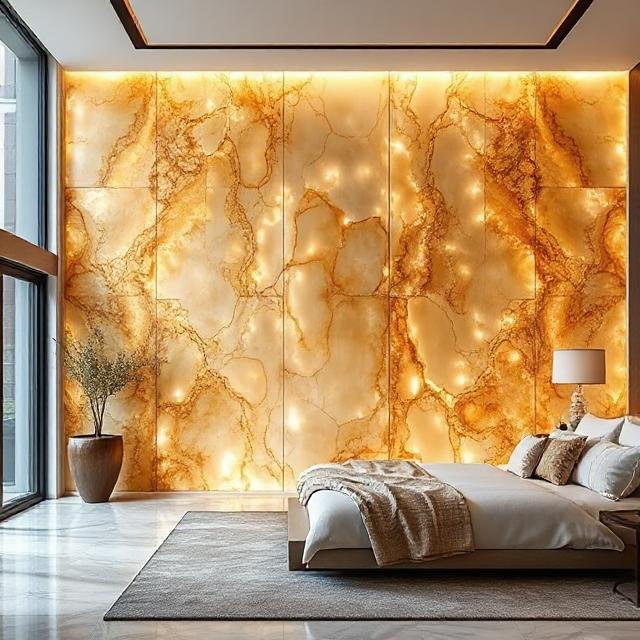Onyx marble does not just transform the space with its extraordinary realms of luxury; it gives a sophisticated appeal to any space. It is most suitable for commercial and residential spaces. The exotic material stands apart from traditional marble, tiles, and granite due to its one exceptional property, i.e., translucency. It illuminates when light rays fall on it, ceases to be a mere surface, and becomes a more attractive, glowing work of art. It is used for high-end projects.

The Magic of Translucency
Onyx is a natural stone that is formed from calcium carbonate deposits. It has a delicate layered structure that allows the light to penetrate easily. When the LED lights or natural light fall on the surface, it reflects the space and brightens the space. It can be installed behind a thin slab that has swirling veins and vibrant hues such as gold, serene to bold green, and orange shades.
These dramatic shades create an ethereal glow that adds more value, warmth, and unparalleled depth to the area. It has an immersive experience that makes a powerful design and epic statement. It elevates the ambiance to a breathtaking space.

Applications in Luxury Design
The special features of Onyx marble make it the best choice for architects and homeowners for creating luxurious, high-end projects.
- Backlit Feature Walls: The most iconic use of onyx is wall panels in a foyer, master bedroom, or living room, which elevates the space and creates a spectacular focal point, radiating a soft and ambient light that shifts the mood of the complete room.
- Glowing Bar and Reception Counters: In the restaurants, clubs, and high-end homes, the backlit onyx bar top or counter tables can be installed. It highlights its natural pattern into a magnificent conversational piece.
- Luxurious Bathrooms: It can be used for vanity tops, bathtub cladding, and shower areas. Onyx can transform the bathroom into a spa-like sanctuary. The soft illumination from a backlit vanity creates a warm light.
- Designer Furniture: The smaller slabs of onyx are perfect for creating fireplace surroundings, decorative panels near TV cabins, tabletops, and dining table tops, where the stone’s beauty can be admired up close. Onyx can be installed.
Considerations for Working with Onyx
The stunning Onyx natural stone is softer and more delicate than granite and other marble types. Hence, proper installation must be done cautiously, as it tends to break, and maintenance is the key to preserving the beauty of the stone.
- Reinforcement: Due to its fragility, Onyx marble is often backed with some resin or even fiberglass during the fabrication to strengthen and increase the stability for large slab installation.
- Backlighting System: The LED color temperature is an important choice, as it can impact the Onyx stone’s visibility. Regularly the lighting system must be maintained.
- Sealing and Care: As an onyx stone is porous in nature, it requires periodic sealing to protect against any stains and etching. Always use pH-neutral cleaners that must be used for maintenance.
Conclusion: A Living Work of Art
Onyx marble is more than a material; it is an investment in artistry and luminosity. Its unparalleled translucence offers a unique way to integrate natural beauty and custom lighting into luxury interiors, providing a dynamic visual experience that changes with the light of the day or the setting of the room. For those seeking to infuse their space with dramatic elegance and a bespoke glow, the backlit onyx slab remains the definitive choice for sophisticated, world-class design.

FAQs on Onyx Marble Slabs
Q1: Is onyx marble an actual type of marble?
A: Technically, no. While often grouped with marble, onyx is a form of calcite (a type of limestone) deposited in caves or hot springs, giving it its distinct, banded appearance and crucial translucent properties, which true marble does not possess.
Q2: Is onyx durable enough for kitchen countertops?
A: Onyx is softer and more porous than granite or quartz, making it susceptible to scratching, etching (from acidic liquids), and staining. It is generally recommended for low-traffic areas like bathroom vanities, fireplace surrounds, or decorative bar tops, rather than busy main kitchen countertops.
Q3: How is onyx backlit?
A: Backlighting is achieved by installing a specialized, uniform lighting system—typically LED light panels or strips—behind the onyx slab. A small gap (usually $1.5″$ to $3″$ ) is left between the light source and the stone to allow for even light diffusion and to ensure the lighting can be accessed for future maintenance or replacement.
Q4: How do I clean and maintain onyx?
A: Onyx requires careful maintenance. It should be sealed periodically (usually once a year). For cleaning, use only a soft cloth and a pH-neutral stone cleaner. Avoid abrasive pads, scouring powders, and acidic substances like vinegar, lemon juice, or harsh chemical cleaners, as they can etch the surface.


